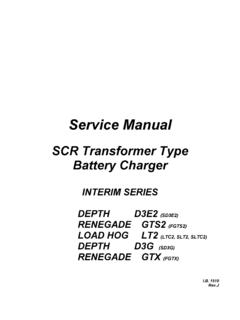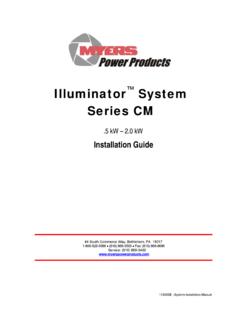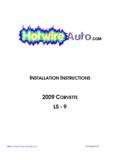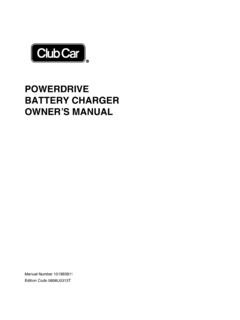Transcription of 1KVA-5KVA INVERTER / CHARGER - solarwholesale.co.za
1 1 KVA-5 KVA INVERTER / CHARGER Version: User Manual Table Of Contents ABOUT THIS MANUAL .. 1 Purpose .. 1 Scope .. 1 SAFETY INSTRUCTIONS .. 1 INTRODUCTION .. 2 Features .. 2 Basic System Architecture .. 2 Product Overview .. 3 INSTALLATION .. 4 Unpacking and 4 Preparation .. 4 Mounting the Unit .. 4 Battery Connection .. 5 AC Input/Output Connection .. 7 PV Connection .. 8 Final Assembly .. 9 Communication Connection .. 10 Dry Contact Signal .. 10 OPERATION .. 11 Power ON/OFF .. 11 Operation and Display Panel .. 11 LCD Display Icons .. 12 LCD Setting .. 14 Display Setting .. 20 Operating Mode Description .. 23 Fault Reference Code .. 24 Warning Indicator .. 25 SPECIFICATIONS .. 26 Table 1 Line Mode Specifications .. 26 Table 2 INVERTER Mode Specifications .. 27 Table 3 Charge Mode Specifications.
2 28 Table 4 General Specifications .. 29 TROUBLE SHOOTING .. 30 Appendix: Approximate Back-up Time Table .. 31 1 ABOUT THIS MANUAL Purpose This manual describes the assembly, installation, operation and troubleshooting of this unit. Please read this manual carefully before installations and operations. Keep this manual for future reference. Scope This manual provides safety and installation guidelines as well as information on tools and wiring. SAFETY INSTRUCTIONS WARNING: This chapter contains important safety and operating instructions. Read and keep this manual for future reference. 1. Before using the unit, read all instructions and cautionary markings on the unit, the batteries and all appropriate sections of this manual. 2. CAUTION --To reduce risk of injury, charge only deep-cycle lead acid type rechargeable batteries.
3 Other types of batteries may burst, causing personal injury and damage. 3. Do not disassemble the unit. Take it to a qualified service center when service or repair is required. Incorrect re-assembly may result in a risk of electric shock or fire. 4. To reduce risk of electric shock, disconnect all wirings before attempting any maintenance or cleaning. Turning off the unit will not reduce this risk. 5. CAUTION Only qualified personnel can install this device with battery. 6. NEVER charge a frozen battery. 7. For optimum operation of this INVERTER / CHARGER , please follow required spec to select appropriate cable size. It s very important to correctly operate this INVERTER / CHARGER . 8. Be very cautious when working with metal tools on or around batteries. A potential risk exists to drop a tool to spark or short circuit batteries or other electrical parts and could cause an explosion.
4 9. Please strictly follow installation procedure when you want to disconnect AC or DC terminals. Please refer to INSTALLATION section of this manual for the details. 10. Fuses (3 pieces of 40A, 32 VDC for 1 KVA, 4 pieces of 40A, 32 VDC for 2 KVA and 6 pieces for 3 KVA, 1 piece of 200A, 58 VDC for 4 KVA and 5 KVA) are provided as over-current protection for the battery supply. 11. GROUNDING INSTRUCTIONS -This INVERTER / CHARGER should be connected to a permanent grounded wiring system. Be sure to comply with local requirements and regulation to install this INVERTER . 12. NEVER cause AC output and DC input short circuited. Do NOT connect to the mains when DC input short circuits. 13. Warning!! Only qualified service persons are able to service this device. If errors still persist after following troubleshooting table, please send this INVERTER / CHARGER back to local dealer or service center for maintenance.
5 2 INTRODUCTION This is a multi-function INVERTER / CHARGER , combining functions of INVERTER , MPPT solar CHARGER and battery CHARGER to offer uninterruptible power support with portable size. Its comprehensive LCD display offers user-configurable and easy-accessible button operation such as battery charging current, AC/solar CHARGER priority, and acceptable input voltage based on different applications. Features Pure sine wave INVERTER Built-in MPPT solar charge controller Configurable input voltage range for home appliances and personal computers via LCD setting Configurable battery charging current based on applications via LCD setting Configurable AC/Solar CHARGER priority via LCD setting Compatible to mains voltage or generator power Auto restart while AC is recovering Overload/ Over temperature/ short circuit protection Smart battery CHARGER design for optimized battery performance Cold start function Basic System Architecture The following illustration shows basic application for this INVERTER / CHARGER .
6 It also includes following devices to have a complete running system: Generator or Utility. PV modules (option) Consult with your system integrator for other possible system architectures depending on your requirements. This INVERTER can power all kinds of appliances in home or office environment, including motor-type appliances such as tube light, fan, refrigerator and air conditioner. Figure 1 Hybrid Power System 3 Product Overview 1-3 KVA model NOTE: For parallel model installation and operation, please check separate parallel installation guide for the details. 1. LCD display 2. Status indicator 3. Charging indicator 4. Fault indicator 5. Function buttons 6. Power on/off switch 7. AC input 8. AC output 9. PV input 10. Battery input 11. Circuit breaker 12. RS232 communication port 13.
7 Parallel communication cable (only for parallel model) 14. Current sharing cable (only for parallel model) 15. Dry contact 4 KVA/5 KVA single model 4 KVA/5 KVA parallel model 4 INSTALLATION Unpacking and Inspection Before installation, please inspect the unit. Be sure that nothing inside the package is damaged. You should have received the following items inside of package: The unit x 1 User manual x 1 Communication cable x 1 Software CD x 1 Preparation Before connecting all wirings, please take off bottom cover by removing two screws as shown below. Mounting the Unit Consider the following points before selecting where to install: Do not mount the INVERTER on flammable construction materials. Mount on a solid surface Install this INVERTER at eye level in order to allow the LCD display to be read at all times.
8 The ambient temperature should be between 0 C and 55 C to ensure optimal operation. The recommended installation position is to be adhered to the wall vertically. Be sure to keep other objects and surfaces as shown in the right diagram to guarantee sufficient heat dissipation and to have enough space for removing wires. SUITABLE FOR MOUNTING ON CONCRETE OR OTHER NON-COMBUSTIBLE SURFACE ONLY. 5 Install the unit by screwing three screws. 1-3 KVA 24V, 1 KVA/3 KVA 48V model 2-3 KVA 24V/48V Plus, 4-5 KVA 48V model Battery Connection CAUTION: For safety operation and regulation compliance, it s requested to install a separate DC over-current protector or disconnect device between battery and INVERTER . It may not be requested to have a disconnect device in some applications, however, it s still requested to have over-current protection installed.
9 Please refer to typical amperage in below table as required fuse or breaker size. WARNING! All wiring must be performed by a qualified personnel. WARNING! It's very important for system safety and efficient operation to use appropriate cable for battery connection. To reduce risk of injury, please use the proper recommended cable and terminal size as below. Recommended battery cable and terminal size: Model Typical Amperage Battery Capacity Wire Size Ring Terminal Torque Value Cable mm2 Dimensions D (mm) L (mm) 1 KVA 48V 20A 100AH 1*14 AWG 2 2~ 3 Nm 1 KVA 24V, 2 KVA 48V 33A 100AH 1*10 AWG 5 2~ 3 Nm 3 KVA 48V 50A 100AH 1*8 AWG 8 2~ 3 Nm 2 KVA 24V 66A 100AH 1*6 AWG 14 2~ 3 Nm 200AH 2*10 AWG 8 3 KVA 24V 100A 100AH 1*4 AWG 22 2~ 3 Nm 200AH 2*8 AWG 14 4 KVA 66A 200AH 1*4 AWG 22 2~ 3 Nm 2*8 AWG 14 5 KVA 87A 200AH 1*4 AWG 22 2~ 3 Nm 2*8 AWG 14 Ring terminal: 6 Please follow below steps to implement battery connection: 1.
10 Assemble battery ring terminal based on recommended battery cable and terminal size. 2. Connect all battery packs as units requires. It s suggested to connect at least 100Ah capacity battery for 1-3 KVA model and at least 200Ah capacity battery for 4 KVA/5 KVA model. NOTE: Please only use sealed lead acid battery or sealed GEL/AGM lead-acid battery. 3. Insert the ring terminal of battery cable flatly into battery connector of INVERTER and make sure the bolts are tightened with torque of 2-3 Nm. Make sure polarity at both the battery and the INVERTER /charge is correctly connected and ring terminals are tightly screwed to the battery terminals. WARNING: Shock Hazard Installation must be performed with care due to high battery voltage in series. CAUTION!! Do not place anything between the flat part of the INVERTER terminal and the ring terminal.






